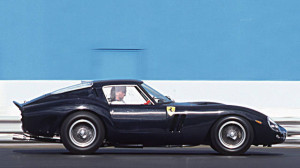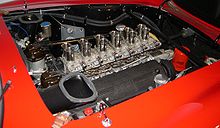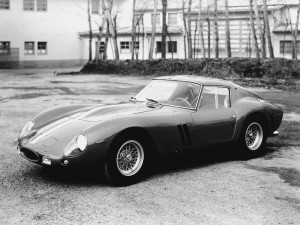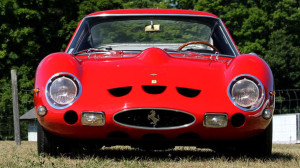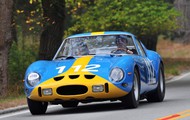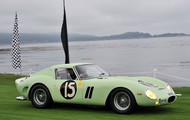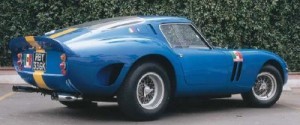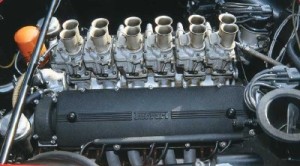Ferrari 250 GTO: of unprecedented beauty
The Ferrari 250 GTO is a GT car which was made by Ferrari from 1962 till 1964 for the homologation of the FIA’s Group 3 Grand Touring Car category. The ’250′ in the name represents the one-cylinder capacity expressed in cubic centimetres and GTO stands for ‘Gran Turismo Omologata’, Italian for ‘Grand Touring Homologated’. A new GTO could be purchased for $ 18.000 in the US and buyers were to be approved of by Enzo Ferrari himself and his dealer in North-America, Luigi Chinetti.
In 1962/63, 36 GTOs were manufactured. In 1964, the ‘Series II’ was introduced with a slightly different appearance. Three of those cars were manufactured and four ‘Series I’ were converted to the 1964 version, adding up to 39 GTOs in total.
Pic.: Ferrari 250 GTO ‘Series II’
The 250 GTO was designed in order to be used in GT Racing. It was based on the 250 GT SWB. Chief engineer Giotto Bizzarini removed the 3-litre V12 motor from the 250 Testa Rossa and put it in the chassis of the 250 GT SWB. He and designer Sergio Scaglietti jointly designed the coach. After Bizzarini and the majority of the remaining Ferrari engineers were fired following a difference of opinion with Enzo Ferrari, the development route was passed on to Mauro Forghieri. He worked together with Scaglietti to further develop the exterior of the car, including the wind tunnel and track testing. Contrary to most of Ferraris, the 250 GTO had not been designed by an individual or particular designer bureau.
Pic.: the V12 of the 250 GTO
The remaining parts of the car were typical of the Ferrari technology in the early 60s: a hand-welded tube frame, A-arm front-wheel suspension, ‘live-axle’ back-wheel suspension, disc brakes and Borrani capstan wheels. The five gearbox originally designed by Porsche was new in the Ferrari GT racing cars; the metal plate inside which the gear lever was changing became traditional to Ferrari and can still be found in the new models. The interior was extremely basic, even with lack of a speedometer on the dashboard. Many of the switches were from the Fiat 500.
Pic.: the 250 GTO interior
The 1962 FIA regulations required that 100 samples of a car be built in order to be homologised for the Group 3 Grand Touring Car races. However, Ferrari produced only 39 samples of the 250 GTO: 33 ‘normal’ cars, 3 with the four-liter 330 motor (also called the 330 GTO, recognizable by the large bump on the bonnet) and 3 ‘Type 64′ cars with an altered appearance. Ferrari circumvented the FIA regulations by not numbering the chassis numbers in sequence, suggesting the construction of cars that did not exist.
The 250 GTO made its debut in the 12 Hours of Sebring in 1962, driven by the American Phil Hill (Formule 1 world champion at that time) and the Belgian Olivier Gendebien. Although the pair was initially annoyed that they had to drive a GT class car instead of a full-race Testa Rossa competing in the prototype class, the experienced couple deeply impressed themselves and everyone else by finishing second behind the Testa Rossa of Bonnier and Scarfiotti.
This was followed by convincing victories at Goodwood in England and in France on the Auvergne and Monthlery circuits where the Ferraris claimed four out of five highest positions.
At Le Mans Jean Guichet and Pierre Noblet won the GT class and they finished, unbelievably, second with an average speed of 113,077 mph (182,673 km/h) only to be exceeded by the speed of the winning Ferrari 330 LM, 115,245 mph (185,469 km/h). The other GTOs were outpaced and finished third and sixth. Later that year they finished second again twice, on the Nürburgring and the Bridgehampton circuit (USA).
In 1963, the achievements were comparable to those in 1962. Overall victories were gained at Daytona, Florida (Pedro Rodriguez), Spa in Belgium (Willy Mairesse), during two important Goodwood races (Mike Parkes and Graham Hill) and in the Tour de France (Guichet/Jean Behra). At Le Mans the 250 GTO won again the GT class and finished second overall.
Eventually, the 250 GTO was to win the FIA International Championship for GT Manufacturers in the < 2 liter class in 1962, 1963 and 1964. The 250 GTO was one of the latest front-engine cars to remain competitive in the top of car racing.
Below you will find the main technical data of the 250 GTO:
Engine
Typefront, longitudinal 60° V12
Bore/stroke73 x 58.8 mm
Unitary displacement246.10 cc
Total displacement2953.21 cc
Compression ratio9.8 : 1
Maximum power221 kW (300 hp) at 7400 rpm
Power per litre102 hp/l
Maximum torque-
Valve actuationsingle overhead camshafts per bank, two valves per cylinder
Fuel feedsix Weber 38 DCN carburettors
Ignitionsingle spark plug per cylinder, two coils
Lubricationdry sump
Clutchsingle-plate
ChassisFrametubular steel
Front suspensionindependent, unequal-length wishbones, co-axial coils and telescopic shock absorbers, anti-roll bar
Rear suspensionlive axle, twin radius arms, semi-elliptic springs, co-axial coil springs and telescopic shock absorbers
Brakesdiscs
Transmission5-speed + reverse
Steeringworm and roller
Fuel tankcapacity 130 litres
Front tyres6.00 x 15
Rear tyres7.00 x 15
Bodywork
Typetwo-seater berlinetta
Length4325 mm
Width1600 mm
Height1210 mm
Wheelbase2400 mm
Front track1354 mm
Rear track1350 mm
Weight880 kg (dry)
Performance
Top speed280 km/h
Acceleration 0-100 km/h-
0-400 m-
0-1000 m-
Note to the Technical Details:
The listed details are those published by Ferrari at the model’s presentation. For the models produced in the participating in these two categories) and Gran Turismo. (the road-going cars, many of which also took part in various international races).
first years no external measures of the body were given, because those could vary from car to car. All models from Ferrari have been divided into three categories: single-seater, Sport/Prototype (theThe year of all the models’ introductions is the debut in competitions for the single-seaters and Sport /Prototypes and the official presentation as far as the Gran Turismo are concerned.
Jaap Bakker
Leave a Reply


